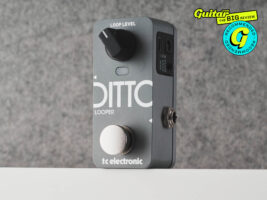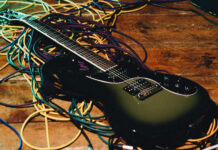
TC Electronic Ditto 2 review: “The most easy to use looper on the market just got even better”
$119/£80, tcelectronic.com
It’s easy to forget that before the original TC Electronic Ditto appeared back in 2013, loopers were quite scary things. Sure the concept had been around for a long time, and in the years immediately prior, Ed Sheeran had shown that a guitarist plus a loop pedal could be a vehicle to pop superstardom… but they were fiddly things.
READ MORE: Headrush FRFR Go review – “An idea so good it’s amazing nobody has thought of this sooner”
This was the era of Akai Headrushes and Boss Loop Stations – powerful and feature-packed units, yes, but also the sort of thing that required at least a cursory glance through the manual to get to grips with.
TC Electronic realised, quite brilliantly, that a lot of guitarists hate that shit – and the absolute worst thing you can do to someone tentatively exploring a new musical concept or tool is to require they read a Borrower-printed book before you even get started.
Thus, the Ditto was born – a pedal that distilled the pure uncut good stuff that guitar players wanted to get from a looper pedal, and gave it to them for a killer price. There were no menus to navigate here, no memory banks to draw from – just a knob for the level, and a multi-function footswitch that did everything you needed it to do out of the gate: record, overdub, play, pause, erase, done.
And it was a hit – alongside the PolyTune it was probably the most impactful TC Electronic pedal of all time, and became a firm favourite with guitarists of every stripe: from open-mic giggers to Joe Perry and Andy Summers.
The concept has since spawned an entire family of variations on the theme, but there’s never been an actual version two of the concept – at least, that is, until now…
Image: Adam Gasson
TC Electronic Ditto 2 – what is it?
The original Ditto was a mini-pedal sized looper with a single multi-function footswitch and a level knob, that offered up to five minutes of 24-bit audio looping. The Ditto 2 is also mini-pedal sized, but with a more rounded enclosure, a redesigned multi-function footswitch with a larger switch and a magnetic mechanism, a single level knob, and up to 10 minutes of 32-bit audio looping. So, straight off the bat then, this feels like an upgrade, but there’s more at play here than just bumping up the power.
The Ditto 2 introduces something that TC calls ‘LoopSnap’ – which promises to make looping more user-friendly than ever. Effectively, this seems to build on the very clever tech seen in the Ditto Jam X2 – that band-focused unit was clever enough to listen, and slow the loop down to compensate based on the rhythm your band was playing. LoopSnap does something similar, but different – it’s able to correct slight timing errors at the start or end of the loop, ensuring that your loops stay in time even if you’re a little sloppy with your overdubs (hello!).
What’s more, the Ditto 2 adds a bunch of optional but useful app-based functionality. Unlike the original Ditto, the new version adds a small three-way toggle on the pedal’s side that enables you to select from either the classic Ditto functionality, or a user preset that by default is set up for old school single-tap looping (ie it’s a single tap to record, play and clear in that order).
Hook it up to the app and you can mess around with this, including choosing whether to have true or buffered bypass active, and for the more robotic amongst us, you can opt to turn off the LoopSnap functionality altogether on either the Ditto or User modes.
Image: Adam Gasson
TC Electronic Ditto 2 – build quality
The most striking departure from the original Ditto with the Ditto 2 is of course the footswitch – it’s certainly not the standard switch that you see on most pedals. For starters you have the large domed button, which is designed to be rugged and dependable whether you’re hammering it with boots or in bare feet – it almost looks as though someone’s already installed a teeny footswitch topper on it, and that’s absolutely a good thing.
But the looks are only part of it – the reliability of footswitches are an oft-cited bugbear of loop pedals, the Ditto included. The nature of looping means these switches are often getting hammered many more times than a normal pedal switch would be so they need to be rugged and reliable.
To deal with this issue, TC has used a magnetic mechanism for the Ditto rather than a mechanical one – in theory this should be much more reliable and less prone to breakage than a classic footswitch. In practice, it means that instead of a classic ‘click’ you get a very meaningful ‘thunk’ when you depress the switch, with a noticeable magnetic push back on release – it does feel very much like you’re pushing two magnets apart, which I suppose you are. I say suppose, because my efforts to open this up and have a look at exactly how this thing works were thwarted by TC’s standing but rather unhelpful decision to use torx screws instead of a regular Phillips screw to secure the backplate. Boooo, TC, boooo! Let us see the fancy switch!
It does add to the consumer tech vibe of the pedal as a whole – with its matt finish, stylishly rounded edges and multi-colour status LED. But enough about looks, how does it loop!?
Image: Adam Gasson
TC Electronic Ditto 2 – ease of use
With the Ditto 2 in Ditto mode, I plug it into my signal chain and after a brief second to boot up, we’re off to the races. The multi-colour LED really is super-helpful at getting you up and looping – it turns red when you hit record, then green when it’s playing back. Another tap will get you into overdub mode and the LED turns purple, while you can stop the whole thing by giving it a double-tap at which point it pulses yellow letting you know there’s something in the bank. Pressing and holding in this mode erases the whole lot, reverting it back to white, and if you do this while you’re playing back it acts as an undo/redo for the last overdub you put in there.
The other colour you’ll find is blue, which is the colour it pulses when you’ve got the pedal in Bluetooth pairing mode and it’s here where I hit my first issue. Despite using an iPhone Pro Max – the most friendly and generic of smartphones for this sort of thing, I found the ability to pair with the Ditto 2 extremely patchy at best. It took multiple attempts, phone restarts and clean app installs to get it to play ball. Now, I should point out that I was using a pre-release version of the app, but we’ve seen spotty app connectivity issues with pedal brands too many times now – the iOS walled garden is usually the most reliable option for these things, so I wish Android users the best of luck.
The good news is that really, you could get everything you need out of this pedal without ever connecting it to the app – the Ditto mode is simple and easy to use as it always was, and it works just as well as the Ditto always has.
The LoopSnap mode is on by default, but in practice it’s perhaps not the game-changer for sloppy loopers that I had hoped. TC says that LoopSnap will correct a timing error of around 150ms at the start or end of the loop, and provided the rhythm and content of said loop is pretty simple it does a fine job of that. The issue is that 150ms really isn’t a lot of time, and so it’s really more of a thing that can polish a very nearly in-time loop – if you really fluff something you’ll still end up having to redo it.
It’s a little disappointing then, but perhaps it’s kinda inevitable – by making the time correction span longer it might mess more overtly with the loop’s content, and it’s worth remembering that this is designed to be the most streamlined and easy to use looper around – it’s best to think of it more as an occasionally useful bonus than a gig-saver.
Speaking of gigs, another slightly annoying thing from a performance capacity is the fact that when you stop a loop and then hold to delete it, you’ll hear a momentary rapid burst of the loop in question as it’s deleted. For some reason, this doesn’t happen if you press and hold directly as you double-tap to stop the loop, which is a workaround, but it’s rather baffling that it does it at all.
Image: Adam Gasson
TC Electronic Ditto 2 – should I buy one?
The Ditto 2 is an interesting product precisely because for the last decade TC has seemingly been on a mission to complicate and belabour the Ditto concept. While the other half a dozen Ditto-derived products released since then have all had their uses and fans, 2021’s Ditto+ did seem to imply that complexity was the way forward – with its LCD screen, loop stacking and uploadable hour-long memory.
The Ditto 2 is a rather refreshing renewal of what made the original Ditto such a hit. It strips back all the extraneous features the product line gained over the last 12 years and returns it to the core job: being the most easy to use looper on the market… but better.
All that, and it’s still just $120 – if you don’t have one on your ‘board already, there’s never been a better time to change that.
TC Electronic Ditto 2 – alternatives
TC pretty much invented the mini-pedal looper market, but now you’ll find them all over the place. One of the cheapest is the Mooer Micro Looper ($89/£69) though EHX’s Pico 360+ ($139/£129) is similarly cheap and compact. If you want a bit more control for your buck, the Boss RC-1 ($99/£99) has an optional footswitch out to better control your loops, while the Zoom MS-90LP+ ($139/£133) offers a bunch of deeper functionality, including built-in rhythms and stereo outs.
The post TC Electronic Ditto 2 review: “The most easy to use looper on the market just got even better” appeared first on Guitar.com | All Things Guitar.
Source: www.guitar-bass.net












